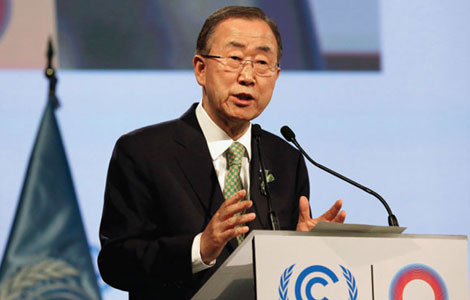After multilateral summits, China pursues bilateral progress
Updated: 2014-12-11 22:40
By Stephan Mothe(China Daily USA)
|
||||||||
This year the G-20 Summit wrapped up with much hype about the pledge by member countries to add $2 trillion to the global economy by 2018 by following roughly 1,000 broad policy measures.
As is necessarily the case with a coalition so disparate, the details of those policies will have to be worked out through bilateral negotiations. Some parties will undoubtedly fail to make much progress, either because the goals are unrealistic or because the political will to pursue them is lacking. China will not be one of those parties. In fact, it already has a head start.
One of the G-20 Summit's tangible results has been the creation of a body charged with coordinating the work of governments, companies, and development banks to spur investment in infrastructure. Yet China's policy banks have been financing infrastructure development throughout the Global South for years. Much of the construction has also been handled by Chinese firms. These actions were made possible by a deliberate effort to identify specific investment opportunities and reach deals through a combination of diplomacy and business savvy. For all the pomp and pageantry of high-profile international summits, it is apparent that the most important negotiations are bilateral.
Following APEC, China and the United States made headlines with their climate change agreement, in which they committed to quantifiable emissions targets. A Free Trade Agreement with South Korea also sent shockwaves throughout the region. However, some lower key achievements should not be overlooked. New trade and investment deals inked with Brazil and a cooperative structure setup with Mexico promise to add new life to China's strategic partnerships and provide Latin America's two largest economies with a much needed boost.
After spending two years on a blacklist following an unconfirmed case of mad cow disease in 2012, Brazilian beef will finally be allowed back into the Chinese market beginning in January. Brazil's Minister of Agriculture Neri Geller estimated that those exports would be worth $300 million to $400 million in the first year, with the potential of reaching $1.2 billion in 2015.
At the same time, China agreed to allow imports of Brazilian transgenic corn. Perhaps more importantly though, during a head-of-state meeting on the sidelines of the G-20 Summit, President Xi Jinping pledged to promote railway construction in Brazil, specifically freight rail, high-speed rail and a transcontinental South American railway.
All of this is good news for a country whose economic prospects have not been described in the best light. Brazil has a dire need to upgrade its infrastructure in order to counter what is known as the “Brazil Cost” – by one estimate, poor transportation infrastructure adds 25 percent to the price of soy beans. Another must for Brazil is diversifying its exports, which are mainly composed of agricultural goods and natural resources, to better withstand fluctuations in the global economy.
President Dilma Rousseff, who was barely re-elected to a second term in October and whose administration is overseeing a messy corruption scandal involving the state oil company, has more than enough sufficient incentive to make the most of her country's comprehensive strategic partnership with China.
Shortly before the G-20 Summit, a meeting between Xi and President Enrique Peña Nieto led to the establishment of the 1-2-3 bilateral cooperation structure between China and Mexico. According to Xi, financial cooperation will be the engine, trade and investment will be the mainlines, and infrastructure, energy and high-tech will be the emphases. For similar reasons to Brazil, Peña Nieto seemed most interested in getting China involved in infrastructure development. His government unveiled an ambitious 5-year plan to invest up to $300 billion in transportation, telecommunications, water, energy, health and education. China has been named as a likely source of funding, and the creation of an infrastructure investment fund is said to be in the works.
China and Mexico signed their own strategic partnership agreement in 2013, and there are clear win-win scenarios on the horizon. Faced with unrest following the abduction of 43 students and a lackluster response by his government, Peña Nieto needs to deliver positive news soon or risk losing the confidence of his population, especially in the country's interior. Expanding telecommunications networks in rural areas to increase connectivity in places in which the state often fails to make its presence felt may be a good way to do so. The investment is estimated at $750 million. Additionally, the construction of infrastructure to facilitate oil and gas exports should also be of interest to China.
Public commitments to ambitious targets are laudable, but without working out practical matters they cannot be achieved. China is proving that when the will exists, those challenges can be overcome. Its relationships with Latin America's largest economies show promise and progress, and sustained efforts will surely yield rewards. Aside from trade and investment, there are opportunities to cooperate on climate change, security, international organization reform and even massive events such as the Rio Olympics. Challenges, including the need to take environmental concerns into account and provide an acceptable degree of transparency remain, but can be dealt with. Next year, Beijing will host the first meeting of a new forum for China-Latin America cooperation, the first multi-lateral organization between China and the region. Much like with APEC and G-20 though, we can expect the real progress to be achieved on the sidelines.
The author is a market analyst with Euromonitor International based in Rio de Janeiro, Brazil.

 Chinese passport opens more doors in 2014
Chinese passport opens more doors in 2014
 China faces: Glimpses of life and love
China faces: Glimpses of life and love
 Top 10 favorite gift brands of rich Chinese women
Top 10 favorite gift brands of rich Chinese women
 In photos: Group watching
In photos: Group watching
 Pictures of the year: Fashion
Pictures of the year: Fashion
 Across Canada Dec 10
Across Canada Dec 10
 Jack Ma in running for Time magazine Person of Year
Jack Ma in running for Time magazine Person of Year
 China: New climate change fund 'market-based'
China: New climate change fund 'market-based'
Most Viewed
Editor's Picks

|

|

|

|

|

|
Today's Top News
Xi chosen as 'Person of the Year' in Russia
Hypersonic tests target no specific country
Vermont, California, NYC tap into EB-5 program for money
Massacre survivors, relatives urge Japan to reflect in letter to UN
Facebook may need a partner to get into China
BOC adds to China's portfolio of NY property
Watchdog goes online to fight graft
China Construction Bank Toronto Branch Grand Opening Ceremony
US Weekly

|

|








